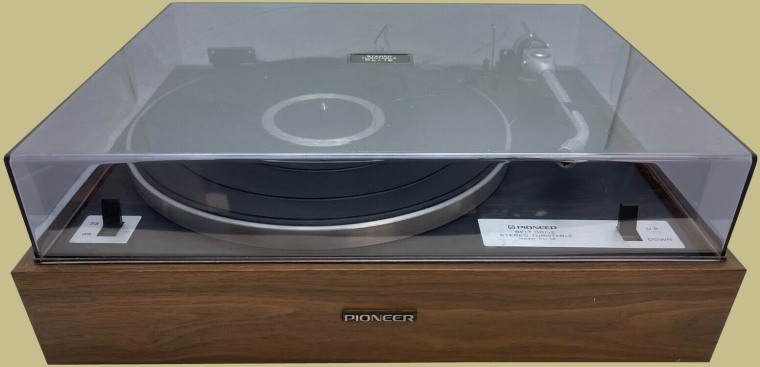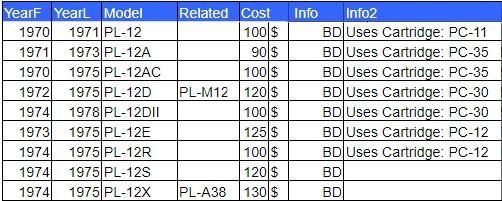
The Pioneer PL-12AC is a manual turntable that was produced from around 1970 until 1975. It was part of Pioneer’s succession of PL-12 models during the early 1970’s. It was at the bottom of Pioneer’s lineup of turntables at the time which included the top-of-the-line PL-61, PL-41DC, PLA-35 and the PL-12AC. The PL-12AC retailed for $99.95. You can see the different models and their original retail pricing in the table below.
The Pioneer PL-12AC is a very nice looking turntable. The simulated wood base and black chassis surface make an appealing combination. With only two controls the turntable is uncluttered and clean looking. Of course, over the years the vinyl covering the base tends to peel and flake which can make it unsightly, but an application of new veneer can bring it back to life.

The PL-12AC was the predecessor of the PL-12D and there are a number of other PL-12 models. The differences between some of them aren’t always obvious. The PL-12AC has a different style tonearm than the other models and it’s anti-skate mechanism is unique as well. Sometimes Pioneer’s model numbers change depending upon the supplied cartridge or lack of a cartridge (the buyer wants to use their own). In fact, the PL-12AC did not come out of the box with a cartridge.
Some speculate that, since the PL-12X is the most expensive, that it might be a quadraphonic model. I’m not sure about that but the PL-12X does have a Start/Stop button, that I believe returns the tonearm to rest when pushed, that the PL-12AC does not have. All the PL-12 models, their years of manufacture, and their retail prices are listed below.
The PL-12AC is a fully manual, belt drive model that runs at either 33 1/3 or 45 speeds. It’s a very basic turntable with only two operating controls (speed, up/down) as it was designed for entry level purchasers. Despite this it performs well due to Pioneer’s choice of quality parts. The Hysteresis synchronous motor is a high quality motor and is unaffected by line voltage fluctuations as well as being very quiet.

The balanced tonearm has a number of adjustments that can be made such as overhang and anti-skating. The anti-skate mechanism is interesting as it utilizes a suspended weight system. I believe it’s the only PL-12 model with this type of mechanism. It can be be a little confusing for those new to tonearm setup so here’s how it’s set:


Another thing to be aware of is that the PL-12AC’s counterweight is not the threaded type where you can screw it in and out to adjust. Instead, it has a small set screw that holds it on the shaft that must be loosened in order to reset its position. Once the counterweight is set properly you can then set the anti-skate.

A prominent audio magazine did some tests on the PL-12AC when it first came out and found it’s basic specs not that far off from other top turntables of the time. They found rumble to measure -54dB, flutter to average 0.04%, and turntable speed to be 0.2% fast at 33 rpm and 0.7% fast at 45 rpm. Not bad for a bottom of the line $100 turntable.

Specifications:
- Motor: 4-pole synchronous motor
- Drive system: belt drive
- Speeds: 33 and 45 rpm
- Platter: 300mm aluminium alloy
- Signal to noise ratio: 45dB or more
- Wow and flutter: 0.1% or less
- Tonearm: static balance type, pipe arm
- Effective length: 221mm
- Dimensions: 17″ x 13 1/2″ x 6 1/2″ (430 x 340 x 160mm)
- Weight: 13.45 lbs (6.1kg)
There are a few issues to be aware of if you’re contemplating purchasing a PL-12AC. The anti-skate weight and string can be lost over the years and replacements are not easily found. The tonearm cueing rest can disintegrate over the years. The original dampening foam pushed into the springs in the sprung chassis has almost always become brittle and deteriorated to the point of being useless. This can cause the table to lose dampening.

A somewhat significant problem that can occur is related to oiling the bearings. There are two small holes under the platter in which you inject oil. These holes lead to two wick lined tubes that go to the motor bearings. It’s not a bad design idea and makes oiling the bearings simple since you don’t have to disassemble the turntable to do it. But, over time these tubes can become brittle and break or become clogged and no oil will reach the bearings – which is bad. The tubes actually look a lot like wires so you need to identify them if you’re working under the chassis on the turntable and be sure not to damage them.
If you’re tonearm is dropping too fast when cueing it’s most likely because the cueing mechanism needs cleaned. Once cleaned you can apply some 300k-500k cst silicone fluid to the shaft which is a little gummy and will slow the fall of the arm when cueing.
Fortunately, you can still find belts, headshells, and other parts for the PL-12AC. For a list of parts currently available on eBay click HERE.

For those who prefer a fully manual turntable with an ease and simplicity of use, Pioneer’s PL-12AC is a good choice. It’s very basic but can perform well when setup properly, and it has a minimalist yet elegant design which will look good in most any environment. The PL-12D and PL-12D II are probably slightly better turntables, and more common, so they might be my first choice but I would still pick up the PL-12AC at the right price.




